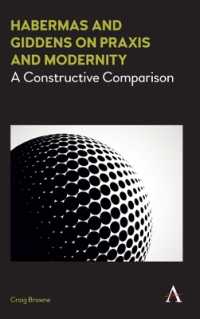- ホーム
- > 洋書
- > 英文書
- > Science / Mathematics
Full Description
In an era of rapid innovation and with a focus on sustainability, Chemical Engineering Essentials provides a definitive guide to mastering the discipline. Divided into two volumes, this series offers a seamless blend of foundational knowledge and advanced applications to address the evolving needs of academia and industry.
This volume lays a strong foundation with topics such as material and energy balances, thermodynamics, phase equilibrium, fluid mechanics, transport phenomena, and essential separation processes such as distillation and membrane technologies.
Volume 2 builds on these principles, delving into reaction engineering, reactor modeling with MATLAB and ASPEN PLUS, material properties, process intensification and nanotechnology. It also addresses critical global challenges, emphasizing green chemistry, waste minimization, resource recovery, and workplace safety.
Together, these volumes provide a holistic understanding of chemical engineering, equipping readers with the tools to innovate and lead in a dynamic and sustainable future.
Contents
Preface xv
Raj Kumar ARYA, George D. VERROS and J. Paulo DAVIM
Part 1. Fundamental Principles 1
Chapter 1. Overview of Chemical Engineering 3
Devyani THAPLIYAL, Kshitij TEWARI, Chitresh Kumar BHARGAVA, Avinash CHANDRA, Pramita SEN, Rahul KUMAR, Amit K. THAKUR, George D. VERROS and Raj Kumar ARYA
1.1. Introduction 3
1.2. History of chemical engineering 4
1.3. Chemical engineering profession 5
1.4. Features and challenges in chemical engineering 6
1.5. Conclusions 14
1.6. References 15
Chapter 2. Fundamentals of Material and Energy Balances 17
Kshitij TEWARI, Devyani THAPLIYAL, Chitresh Kumar BHARGAVA, Avinash CHANDRA, Pramita SEN, Rahul KUMAR, Amit K. THAKUR, George D. VERROS and Raj Kumar ARYA
2.1. Introduction 17
2.2. Process term definitions 18
2.3. Engineering calculations - introduction 21
2.4. International system of units (SI) 22
2.5. Analysis of processes and variables affecting density 25
2.6. Classification of material balances in process fundamentals 29
2.7. General balance equation 30
2.8. Flow charts and process balancing 33
2.9. Degree-of-freedom analysis. 33
2.10. Procedure for calculating material balances in single unit processes 35
2.11. Recycling and bypassing 35
2.12. Limiting reactant 36
2.13. Product separation and recycling 37
2.14. Combustion 37
2.15. Single-phase systems 38
2.16. Clausius-Clapeyron equation 39
2.17. Mass balance problem 42
2.18. Energy and the concept of energy balance 46
2.18.1. Energy balances for closed systems 46
2.19. Energy balances on open systems in the steady state 47
2.19.1. Steady-state energy balance of the open system 48
2.20. Estimation of heat capacity 51
2.21. Estimation and correlation of latent heat 52
2.22. Heats of solution and mixing 53
2.23. Heat of reaction measurement 55
2.24. Energy balance problem 60
2.25. References 63
Chapter 3. Laws of Thermodynamics 65
Girish GUPTA and Neha DHIMAN
3.1. Introduction 65
3.2. Thermodynamical systems 66
3.3. Types of system 68
3.4. Macroscopic system and properties 69
3.5. State of system and state variables 70
3.6. Zeroth law of thermodynamics 71
3.7. Heat 72
3.8. Work 73
3.9. State functions and path functions 73
3.10. First law of thermodynamics 74
3.11. Internal energy is a state function 74
3.12. Work and heat are path functions 75
3.13. Second law of thermodynamics 76
3.14. Thermal energy reservoir 76
3.15. Heat engines 77
3.16. The second law: Kelvin-Plank statement 77
3.17. The second law: Clausius' statement 78
3.18. Refrigerator and heat pumps 78
3.19. References 78
Chapter 4. Thermodynamic Properties and Equations of States 79
Dipaloy DATTA
4.1. Thermodynamic property relations of pure substances 80
4.2. Equations of states 99
4.3. References 102
Chapter 5. Thermodynamics and Phase Equilibrium 103
Vyomesh M. PARSANA, Abhishek GUPTA, Dharmesh SUR and Kedar JOSHI
5.1. Introduction 103
5.2. Fundamentals of thermodynamics 104
5.3. Vapor-liquid equilibrium 111
5.4. Solid-liquid equilibrium 128
5.5. Liquid-liquid equilibrium 130
5.6. References 132
5.7. Further reading 133
Part 2. Fluid Mechanics and Transport Phenomena 135
Chapter 6. Basics of Flow Through Equipment 137
Devyani THAPLIYAL, Kshitij TEWARI, Chitresh Kumar BHARGAVA, Avinash CHANDRA, Pramita SEN, Rahul KUMAR, Amit K. THAKUR, George D. VERROS and Raj Kumar ARYA
6.1. Fundamental laws of fluid mechanics 137
6.2. Pumps, compressors and flowmeters 153
6.3. Pressure drop in designing equipment 164
6.4. Computational fluid dynamics 175
6.5. Conclusions 183
6.6. References 183
Chapter 7. Conduction, Convection and Radiation 189
Thangallapalli SRINIVAS, G. SRINIVAS, B.K. PUROHIT and A.V. RAGHAVENDRA RAO
7.1. Fundamentals of heat transfer mechanisms 189
7.2. Conduction 193
7.3. Convection heat transfer 207
7.4. Radiation heat transfer 220
7.5. References 226
Chapter 8. Diffusion and Mass Transfer Coefficients 229
A.V. RAGHAVENDRA RAO, Rompicherla SRIVIDYA, V. Sravani SAMEERA, K.S.N.V. PRASAD and Thangallapalli SRINIVAS
8.1. Introduction 229
8.2. Diffusion mass transfer 231
8.3. Mass transfer coefficients 244
8.4. Nomenclature 252
8.5. References 253
Part 3. Separation Processes 263
Chapter 9. Extraction 265
Juli DAS, Diptanu DE, Aanchal MITTAL, G.C. JEEVITHA and Sangeeta GARG
9.1. Introduction 265
9.2. Conventional extraction methods 266
9.3. Modern extraction methods 286
9.4. Conclusion 294
9.5. References 295
Chapter 10. Distillation 303
Neha DHIMAN and Girish GUPTA
10.1. Introduction 303
10.2. Applications of distillation process 304
10.3. Relative volatility 305
10.4. Classification of distillation 307
10.5. References 330
Chapter 11. Mathematical Modeling of Binary and Multicomponent Distillation 331
Ananya MUNNANGI, MUTHAMIZHI K., KARTHIKEYAN C., K. TAMILSELVI and A.B. MOHAMMED BASITH
11.1. Introduction 331
11.2. Ideal simple distillation 332
11.3. Nonideal multicomponent distillation 337
11.4. Batch distillation 340
11.5. Applications and advancements 342
11.6. Conclusion 343
11.7. References 343
Chapter 12. Filtration and Membrane Processes 345
Esmaeil ALLAHKARAMI and Ebrahim ALLAHKARAMI
12.1. Introduction 346
12.2. Types of membranes 349
12.3. Membrane fabrication techniques 363
12.4. Application of membrane processes 367
12.5. Membrane fouling 374
12.6. Conclusion 380
12.7. References 381
Chapter 13. Pervaporation 393
Tapas PALAI, Abhishek KUMAR and Leela Manohar AESHALA
13.1. Introduction 393
13.2. Basics of membrane separation processes 394
13.3. Pervaporation 401
13.4. Selection of membrane 413
13.5. Recent developments 418
13.6. Future scope and emerging trends 420
13.7. References 421
List of Authors 427
Index 431
Summary of Volume 2 435








